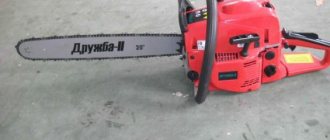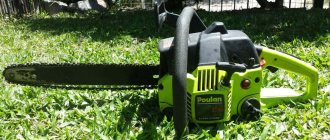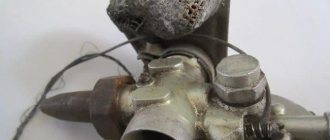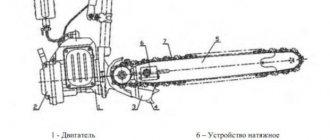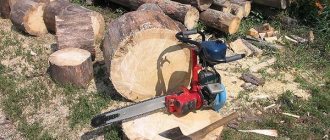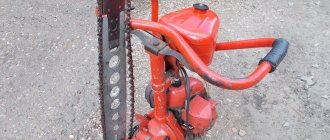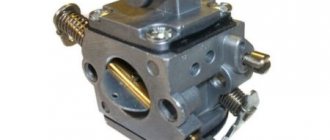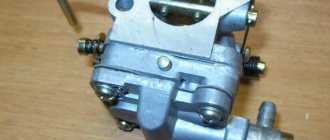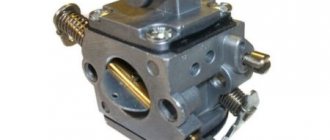The tightness is restored by disassembling the carburetor, changing the gaskets or using a gas-resistant sealant.
All old-style Druzhba-4 chainsaws have KMP-100 carburetors. The KMP-100 is notable for the fact that it was the only carburetor for chainsaws in the country. It was also installed on the Ural chainsaw. And besides the Druzhba and Ural chainsaws, no others were produced or imported into the country. Therefore, we are familiar with the KMP-100 carburetor. It is simple, reliable, and designed with a large margin of safety. On Druzhba-4 chainsaw models produced after 1993, you can find KMP-100A and KMP-100AP carburetors. Today, such carburetors can be found on sale both in the “nameless” version and under the Rezer brand. Options A and AP differ significantly both from each other and from KMP-100 and 100U.
We are looking at the old classic KMP-100 carburetor, which worked on millions of Druzhba-4 chainsaws, many of which are still in use today.
Device
KMP-100 can be considered a new generation carburetor, despite its age. For the first time in the country, an elastic membrane was used instead of a float. Before that, chainsaws used float carburetors, like all two-stroke engines (mopeds, motorcycles, etc.). In a float carburetor, when the carburetor storage chamber is filled, the float floats up and its needle axis cuts off the fuel supply.
The float carburetor cannot operate upside down, which is a big disadvantage for chainsaws. But a diaphragm carburetor can operate in any position, even when the chainsaw is upside down.
The KMP-100 carburetor is made according to the classical design.
- A housing with channels for the supply of fuel and air, a fuel storage chamber and a mixing chamber for the fuel-air mixture (Venturi tube).
- Case cover.
- Throttle (gas) valve.
- Jet with calibrated hole.
- Elastic membrane.
- A rocker arm with a valve that shuts off the fuel supply from the gas tank when the carburetor chamber is filled.
- Two adjustment screws.
- Gaskets.
In total, the Druzhba-4 chainsaw carburetor has 25 parts, including non-removable channels and chambers in the body.
Principle of operation
The KMP-100 carburetor ensures operation of the internal combustion engine in three modes:
- Cold start.
- Low and medium speeds.
- Maximum speed (full throttle).
Before starting the engine, the fuel supply to the engine is shut off by a membrane connected to the valve. Before starting, the fuel is pumped up manually with a pump button (suction or primer). When the engine is started and running, the piston stroke creates a vacuum in the carburetor diffuser. Due to the pressure difference, the membrane bends, presses on the valve and opens the fuel supply. The fuel is mixed with air and, due to the vacuum formed during the stroke of the piston, is sucked into the combustion chamber.
The adjusting screws determine the amount of fuel supplied and the quality of the fuel-air mixture. A fuel mixture that contains a lot of gasoline and not enough air is called enriched.
An overly rich mixture may not burn completely due to lack of oxygen. This leads to excessive fuel consumption or flooding of the spark plug. There is little gasoline in a lean mixture. The engine cannot operate at full power, the mixture is dry, the piston system overheats and wears out faster. Engine speed is regulated by the position of the throttle valve in the carburetor. When it is fully open, the fuel-air mixture flows without restrictions (full gas).
Gas trigger, which regulates the opening of the damper. When it is closed, fuel flows to a minimum and the engine runs at idle speed.
What material is the Druzhba-4 chainsaw carburetor made of?
When assembling the KMP-100 carburetor, parts from different metals are used.
- The KMP-100 carburetor body is cast from an alloy of aluminum and zinc.
- The adjustment and fastening screws are made of steel.
- The jet with a calibrated hole is made of brass.
- The membrane is made of elastic, petrol-resistant plastic.
- The throttle body is made of a steel-based alloy, with additives for resistance to oxidation and corrosion.
- The gaskets are cut from paronite.
The body of more modern KPM 100U carburetors could be cast from an aluminum alloy with the addition of magnesium to lighten the weight.
Advantages: powerful, reliable, maintainable.
Model range overview
All Druzhba chainsaws produced were equipped with an air-cooled MP-1 engine; the air was supplied by a flywheel on which the blades were made. For power supply, a carburetor with a diaphragm was used, which ensured the supply of the mixture regardless of the position of the tool. The high power and weight of the equipment limited the scope of use of the tools that were supplied to logging enterprises. To operate the power unit, a mixture of gasoline and oil for two-stroke engines was used (which was replaced by the M8 engine).
Friendship 2
An early example of a saw, equipped with a 3 hp motor. The handles, made of steel pipe, are bolted to the engine flywheel housing. The design does not provide damping pads at the motor mounting points or a chain brake. The tool is lubricated manually; a centralized fluid supply is not installed. The production of the tool continued for several years, after which chainsaws with an improved design came to replace it.
Friendship 4
The handle is secured to a separate cast clamp placed on the engine crankcase. The MP-1 engine capacity remained the same (94 cm³), but modifications to the gas distribution diagram and installation of a modernized carburetor increased the power to 4 hp. The permissible number of revolutions has also increased (up to 5200 per minute), while the weight of the tool has remained unchanged (12.5 kg). The chain lubrication system was not installed at the factory; the owners subsequently modified the tool themselves.
Friendship 4-A
The shortcomings identified during the industrial operation of early models of Druzhba saws led to the creation of another modification, 4-A. A system for supplying oil to the blade (by gravity) was introduced into the design, and reinforced bearing supports for the crankshaft began to be used. The chainsaw now has an emergency brake that is activated when the chain breaks. The engine was equipped with an improved KMP-100 carburetor and a modernized magneto. The power and other technical characteristics of the saw remained unchanged.
Friendship-4A-Electron
To improve performance characteristics, a transistor ignition unit was installed on the saw, which ensured stable sparking. The engine began to start at low air temperatures without preheating. The rest of the instrument has not undergone any changes.
Friendship 4M Electron
The Druzhba M modification received an automatic lubrication unit for the working chain. The damping elements were modified, and rubber linings with increased wall thickness began to be used on the handles. To prepare the working mixture, a KMP-100U membrane carburetor is used; fuel fluid is supplied by gravity. gbks weight is 12.5 kg; For felling trees, a 450 mm long tire is used.
Friendship-5E
The chainsaw is distinguished by the use of an engine with increased power to 5 horsepower. The design uses a conical main pair, which makes it possible to transmit increased torque and at the same time reduces the weight of the equipment to 11.7 kg. The attachment points of the power unit to the frame are equipped with rubber bushings, which reduce the level of vibration during operation. An automatic chain lubrication system has been introduced using a pump that supplies fluid from a separate tank.
Druzhba-Altai
The saw is a 4M unit assembled at the production site (Altai). The equipment was equipped with a modernized KMP-100U carburetor and a contactless ignition system. A pump is used to supply fuel. The equipment has no external differences, except for the use of a protective casing for the air filter. The chainsaw has improved starting characteristics. Production of products ceased in the second half of the 90s.
Friendship 60
The saw is equipped with a two-stroke single-cylinder engine with a power of 3 hp. with a working volume of 94 cm³. A cable starter with forced return of the cord to the reel is used, the speed control is located on the right handle. A gearbox with a gear ratio of 0.319 is used to drive the chain. Torque from the crankshaft is transmitted to the gears by an automatic centrifugal clutch, which requires adjustment during operation.
Model range of chainsaws Druzhba
The advantages of the Druzhba chainsaw, in addition to those mentioned above, are that it cuts smoothly and accurately, is highly productive and all the parts are in a durable case. Its disadvantages include significant weight - more than 12 kg with dimensions of 86.546x50 cm and a cable starter.
The main difference between modifications of the Friendship chainsaw is engine power:
- Friendship 2 has a power of 2 kilowatts, manual start and, unlike the 1st model, an element for chain braking.
- Druzhba 4, which received “gold” at the World Technology Exhibition in Brussels in 1958, has almost one kilowatt more power, sawing effortlessly, with shaft revolutions of more than five thousand, a half-meter log in one minute.
- Friendship 4M-electron, having a contactless electronic ignition system, uses the engine resource more efficiently, with almost the same power - 3 kW. The cylinder's chrome coating adds wear resistance, and rubber gaskets reduce overall vibration. In modification 4A, an oil pump is installed for forced lubrication of the chain.
Like any other technical device, the Druzhba 4 chainsaw requires constant carburetor adjustment, attention, regular care and preventive maintenance. At least once a year it is necessary to fine-tune the Druzhba 4 carburetor, including its adjustment.
Sharpening teeth
When working with a Druzhba chainsaw, the main load falls on the chain. Therefore, it is important to monitor its condition and periodically sharpen it. The first signs that the chain is dull are:
- Large vibration when cutting.
- Chain oil consumption is too high.
- Not a straight cut.
- Requires high cutting forces.
The rules for properly sharpening teeth on a Druzhba gasoline saw are given in the operating instructions. To do this, you will need a round and straight file, and a depth gauge template. If you can’t sharpen the teeth, you can always skip the repairs and find a new chain on the market.
Advantages and disadvantages
Advantages of petrol saws of the Druzhba series:
- the use of aluminum alloy for the manufacture of the body;
- removable structural elements fixed with threaded connections;
- high power and increased engine torque;
- when the chain jams, the motor does not stop;
- the use of gasoline with an octane rating of less than 80 is allowed;
- the design of the handles allows you to saw wood while standing;
- high build quality (especially products of early modifications);
- chrome plating of the working surface of the cylinder is provided.
Equipment disadvantages:
- there is no emergency stop button for the engine; when the speed drops, the shaft is disconnected from the chain gear by a centrifugal clutch;
- the heavy weight of the saw, making it difficult to carry the product;
- spontaneous loosening of threaded connections;
- high noise level during operation and oil emission from the exhaust pipe;
- the use of an internal combustion engine imposes restrictions on the use of the tool indoors.
Important Terms
The power plants in chainsaws are internal combustion engines, fueled by certain brands of gasoline diluted with the required parts of oil.
Knowledge and strict adherence to the composition of a combustible mixture is the key to long-term operation and productive use of small-scale mechanization units.
The main fuel component is AI grade. It is not recommended to use below or above 92 octane. Optimal for many types of mechanized sawmills, domestic or foreign made.
The ideal ratio of gasoline and oil for a chainsaw:
- increases the productivity of the unit;
- increases service life;
- creates money savings.
The instructions attached to the purchased goods indicate the consumption rates of fuel and lubricating fluid. Violation of the requirements leads to loss of power and premature wear of the internal combustion engine. The truth was obtained through research methods, empirically in our country and abroad.
Most common faults
- The engine does not start. Check for a spark at the spark plug electrodes. Make sure there is no damage to the wire insulation, clean or replace the spark plug if necessary.
- Make sure the fuel tank is tight; interruptions in engine operation are often caused by moisture and condensate getting into the fuel mixture.
- Adjust the carburetor
- The most common cause of overheating is a lack of lubrication. Correct the problem.
- Check the serviceability of the muffler. Its design is quite simple; repairs are possible at home.
- The reason may be a malfunction of the ignition module, as well as a violation of the gap between it and the magnetic circuit in the flywheel. Gap length – from 0.2 mm. up to 0.5 mm.. This value is set using a special gasket, which is located between the flywheel boss and the ignition module. The broken module is replaced. In addition, you can replace the spark plug.
User manual
When working with the Friendship saw, you must follow the operating rules:
- Start-up and operation is prohibited with a damaged or removed air filter;
- the instrument is held with two hands;
- To protect the operator, special clothing and glasses are used;
- at the moment of starting, the saw chain should not touch the ground, stones or other objects;
- It is not allowed to saw wood without filling the tank with oil;
- It is strictly forbidden to refuel the saw with pure gasoline;
- when operating the saw for a long time, it is necessary to take breaks to cool the motor (every 40-45 minutes);
- The tightness of threaded connections is periodically checked;
- If parts of the saw are damaged, operation of the tool is suspended.
Before using the saw, you should read the instructions from the manufacturer. To make a fuel mixture, you need to prepare gasoline and special oil. Half the volume of prepared gasoline is poured into a clean container, then lubricating fluid is added and mixed thoroughly. Then the remaining gasoline is poured into the mixture, the solution is further mixed and filled into the tank. When running in the engine (after replacing the rings), it is recommended to introduce additional oil to ensure the running-in of the rubbing surfaces.
When felling wood, a cut is first made, located on the side where the trunk should fall. Then the trunk is sawed on the other side; There should be no unauthorized persons within a radius of 50 m from the tree being cut down. The operator moves from trunk to trunk with the saw running at idle speed (without chain rotation) or with the engine off. The operating instructions do not allow sawing of trunks tied into logs or stacked.
During operation, it is necessary to adjust the engine idle speed and adjust the carburetor to achieve maximum power. The equipment requires adjustment of the clutch, which overheats during prolonged operation and loses its original characteristics. Since the saw chain stretches during operation, it is necessary to adjust the tension of the element. A correctly tensioned chain moves along the bar by hand and has no sagging in the lower branch.
About safety precautions
Before starting to work with a chainsaw, it is necessary to carry out a number of measures aimed at the safe operation of the device:
- checking the tightness of the fuel system;
- checking the cylinder fastening;
- checking the carburetor is secure;
- checking the muffler is secured;
- checking the tightness of steel fasteners from the outside;
- lubrication of the driven tire sprocket by immersing it in oil for several minutes;
- lubricating the starter cable with lithol-24;
- cleaning the air filter mesh on the carburetor.
It should be remembered that when the interfin cylinder space is clogged, it causes a significant decrease in cooling, severe overheating and accelerated wear of the working surface. After 24 hours of operation, partial disassembly should be carried out, followed by careful removal of carbon deposits.
When working, you must remember to strictly and compulsorily adhere to the following safety rules:
- It is prohibited to carry out work with one hand;
- work clothes must be durable and include gloves, work shoes, as well as a protective helmet and a special shield;
- Before refueling, the gas tank cap must be opened extremely carefully, which is due to the possible presence of gasoline vapors;
- work must be carried out on completely cleared sites, with reliable and strong support;
- you need to make sure that the chainsaw does not touch foreign objects during operation.
Do not refuel with the engine running. The saw should be transported after the protective cover has been placed on the bar.
Technical characteristics of the Druzhba chainsaw
The Druzhba 4 chainsaw has excellent technical characteristics, which makes it stand out among modern professional models. Among the design parameters of the Soviet instrument, the following should be highlighted:
- Engine power – 3.5 l. s./2600 Watt;
- The recommended tire size for work is 45 cm;
- Saw chain pitch – 0.325 “;
- Reservoir for filling fuel – 550 ml;
- Lubricant tank – 260 ml;
- Weight – 7 kg.
Representatives of the 4th generation of Druzhba chainsaws have the highest technical characteristics among the entire line of chainsaws of this brand. By the way, their predecessor, the Druzhba 2 chainsaw, has a power of 2.8 liters. pp., which significantly reduces the ability of the instrument in practical use.
Mixture proportion for “Calm”
The German family company Stihl has production facilities in many countries around the world. The office is located in Waiblingen. Among the range of products produced for the needs of forestry, small-scale mechanization equipment takes pride of place.
Today a liquid golden age has arrived for the Stihl chainsaw:
The manufacturer has set the oil dilution standard at a ratio of 1:50. The proposed proportion establishes the possibility of diluting 1 part of oil in 50 parts of gasoline. Or in a ratio of 1:40.
The calculation is simple. We know that 1 liter of flammable liquid equals 1000 milliliters. Divide the value by 50, we get 20 milliliters of oil. Using a similar algorithm, its volume is determined, recommended in a ratio of 1:40. Having made simple calculations, we get the value of 25 milliliters.
Basic malfunctions and ways to eliminate them
The main malfunctions encountered when operating the Druzhba saw:
- Difficulties starting the engine occur when the level of gasoline in the tank is insufficient or the pipeline is clogged. The defect is observed when the mixture is excessively enriched. To restore performance, it is necessary to blow out the engine by cranking it with a manual starter. If the saw has been stored for several months with a full tank, then the quality of the fuel decreases due to the evaporation of volatile fractions of gasoline.
- The engine does not start due to incorrect ignition adjustment. It is necessary to set the gaps in the contact group in accordance with the instructions. Additionally, the distances between the spark plug contacts are checked.
- Insufficient engine power indicates wear of the piston group or the presence of gaps in the connection between the cylinder and the crankcase. The problem occurs when the jets are clogged, which need to be flushed and the carburetor adjusted.
- Heating of the gearbox housing during operation of the saw indicates a decrease in the lubrication level. To repair a Druzhba chainsaw, you need to introduce a lubricant like Litol-24 or Konstalin-1 into the crankcase of the mechanism.
- Clogging of the air nozzle and jets leads to interruptions in the supply of the fuel mixture and failures in engine operation. To restore functionality, you need to remove the device and wash the parts in clean gasoline. Check the mobility of the throttle valve - if the element is stuck, the air flow does not reach high speeds and does not ensure fuel intake through the jets.
- Violation of the cut geometry indicates improper sharpening or deformation of the teeth.
Engine for moped
The carburetor in the Druzhba chainsaw is responsible for the fuel supply. And you need to be able to customize it for a specific type of work. There can be many reasons for incorrect carburetor settings: heavy load, increased vibration, poor quality of the fuel mixture, etc. Signals that the carburetor has been adjusted incorrectly are:
- Loss of power.
- The gasoline saw does not hold idle speed.
- Excessive fuel consumption.
- Production of smoke or excessive soot.
- Difficult to start or stalls during operation.
Adjusting the carburetor is very simple, the following sequence will help you figure it out:
- There are two screws on the chainsaw that are responsible for supplying fuel at minimum and maximum speeds, and the essence of the adjustment is to change their tension under different loads.
- Initially, you should adjust the supply of the fuel mixture at low speeds.
- Then adjust with another screw at maximum power.
- Adjust operation at idle speed.
- Double-check all modes again.
In order to ensure normal engine operation, the spark plug must have an adjusted electronic gap and be free of lubricant, slag and carbon deposits. This is done so that the spark passes through it normally and does not disappear, and, as a result, the engine does not stall during operation.
To adjust the spark plug, you must do the following:
- Tighten the fuel screw fully.
- Unscrew it 3 turns.
- Screw in the propeller and back it out two full turns.
Seal the adapter coupling with any sealant or place a tin strip. Another reason for the lack of a spark may be the adhesion of dirt on the spark plug, in which case you should simply clean it.
If the excess amount of fuel mixture is eliminated and the functionality of the device is not restored, then it is necessary to adjust the carburetor and clean the muffler. To independently adjust the carburetor, you need to use the following simple recommendations:
- turn the fuel screw all the way;
- unscrew the fuel screw exactly three turns;
- tighten the propeller as tightly as possible;
- unscrew the screw a couple of turns;
- seal using sealant or wrap the adapter coupling with a thin tin strip.
Chainsaws of the “Friendship” model belong to the category of convenient and practical tools that can greatly facilitate everyday life, and are also one of the most popular types in terms of cost, quality and performance. If you follow the operating rules and carry out simple preventive measures, such a tool is striking in its durability and reliability, and self-repair is not difficult even in the absence of special skills.
Electronic ignition unit for chainsaw
Despite the widespread use of imported chainsaws, the population, especially in rural areas, still uses many domestic “Druzhba” and “Ural” machines. Both saws have a common drawback that I also had to deal with - the fragility of the electronic ignition unit. This problem is not new - see the article by P. Ivanov “Repairing the ignition unit of a chainsaw” in “Radio”, 2003, No. 2, p. 45. Nowadays it is not difficult to buy a block, but it is expensive and does not last long. I decided to start developing my own design, which I bring to your attention. Unlike the one mentioned above, the ignition unit does not contain remote elements and fits entirely into the original dimensions of the factory unit. The board of the old unit must be removed. The block diagram is shown in Fig. 1. Generator coil L1, ignition coil (high-voltage transformer) T1, capacitor C1, induction ignition pulse sensor L2 and a duralumin base were used from an old ignition unit. The remaining elements are newly introduced. Rice. 1 Schematic diagram of the device When the flywheel rotates, the generator coil L1 generates an alternating current, which, after rectification by the diode bridge VD1-VD4, charges the capacitor C1. At a certain position of the flywheel, a short pulse of positive polarity appears at the terminals of the sensor coil L2, which, passing through the diode VD5 and the current-limiting resistor R1, opens the thyristor VS1. Capacitor C1 is discharged through an open thyristor and the primary winding of the ignition coil T1. Its secondary winding forms a high voltage pulse, which is then supplied to the spark plug. The amplitude limiter of the opening pulse is assembled on transistor VT1, resistor R2 and zener diode VD6. As long as the voltage on the control electrode of the trinistor VS1 does not exceed the stabilization voltage of the zener diode VD6, the transistor VT1 is closed and does not affect the control electrode circuit. When the zener diode VD6 opens, current begins to flow through it and resistor R2. A voltage appears across resistor R2, which slightly opens transistor VT1, which shunts the control electrode circuit of thyristor VS1. As a result, the pulse amplitude is limited to about 4 V at the zener diode indicated in the diagram. This voltage is enough to reliably open the thyristor. In order for the described design to fit into the dimensions of the factory ignition unit, it is necessary to modify the thyristor. To reduce its length, the threaded shank was shortened (1-2 threads were left), the cathode and control leads were also shortened to a length of 4...5 mm. Before shortening the lead, it must be compressed in two places near the body using side cutters with blunt cutting edges. Then, above these places, the lead is bitten off and the cut is soldered with solder. The terminal can be compressed no closer than 2 mm from the SCR body, otherwise the insulator will crack. This compression is necessary to increase the contact area between the internal conductor coming from the crystal and the external terminal of the SCR. The unit is installed using rigid copper wire with a diameter of 0.4-0.45 mm in vinyl insulation. Diodes VD1 - VD4 are assembled closely into a block and their terminals are soldered in such a way that on one side of the block there are AC terminals, and on the other - DC. The transistor is secured with the screw that was used to secure the factory board. A petal is placed under the transistor, to which the leads connected to the body are soldered. Resistors, diode VD5 and zener diode VD6 are soldered to the terminals of transistor VT1 by surface mounting. Capacitor C1 is placed in the same place, and the bridge VD1-VD4 is placed in the same compartment. The wires from coil L1 to the bridge are flexible, of the same cross-section. The wire going to the anode of the thyristor is soldered to its body. Before filling with the compound, the thyristor is held “suspended” on rigid wires in such a way that it does not protrude beyond the dimensions of the unit, and a gap of about 2 mm remains between the thyristor body and the duralumin base of the generator. After testing for functionality, the assembled unit is filled with epoxy compound, making sure that the parts of all elements close to the edges and the SCR housing are covered with a layer of compound. After the compound hardens, the thyristor is rigidly fixed to the base of the generator. The finished block is shown in Fig. 2. Fig. 2 View of the finished block When installing the block in a chainsaw, it may be necessary to adjust the ignition timing. In practice, it was often necessary to set it earlier relative to the factory mark. If you plan to install the block in a Ural chainsaw, before assembly you need to remove part of the mounting protrusion from the back side of the base, painted in Fig. 3 in blue, flush with the base plane. Under the remaining parts of the protrusion, when installing the block in place, it is advisable to place gaskets made of heat-insulating material, such as asbestos cardboard, with a thickness of no more than 0.5 mm. With a greater thickness, the flywheel may interfere with the block parts. Gaskets are needed because the design of the Ural chainsaw provides for the installation of an electronic ignition unit directly on the wall of the engine crankcase, which becomes very hot during prolonged operation. Rice. 3 Reverse side of the part In the above-described block, instead of those indicated in the diagram, you can use diodes KD105G, KD209 with any letter index, as well as other suitable dimensions with a reverse voltage of at least 400 V and an average forward current of at least 0.3 A. We will replace the KS133A zener diode with KS 139, KS 147, KS 156 with letter indices A, B, G or their imported analogues, provided that the sum of the stabilization voltage of the zener diode VD6 and the voltage of the IBE transistor VT1 does not exceed the permissible voltage at the control terminal of the thyristor. SCR KU202N can be replaced with KU202M, KU205V, KU205G. Tri-nistors in a plastic case should not be used due to their insufficient resistance to overheating. In conclusion, I will add that more than 20 blocks were assembled according to the description provided and they work for a long time and reliably. The unit I assembled and installed on my chainsaw 6 years ago has never failed
Options for doing the job
It is important to know how to sharpen a chainsaw chain at home, so as not to delay the process of working with lumber and not break the tool. Sharpening an electric saw chain with your own hands is no different from straightening the cutting element of a saw with a gasoline engine.
You can choose one of the available methods:
- Straightening teeth using a file is the most common and easiest method, which allows you to sharpen directly on the job site.
- The teeth can be sharpened using the PowerSharp system.
- Using a special sharpening machine - this method is used by service centers, but it can also be used at home.
- Using an angle grinder (grinder). This method is unlikely to be used by inexperienced users, since it is rarely used and requires certain skills.
Shtil chainsaw sharpening angle
It is important to maintain the sharpening angle of the rear corner of the upper blade; this can only be done using a template. It is extremely difficult to achieve this in other ways, because
because its value ranges from 50 to 60°. The angle of the leading edge can be changed depending on what type of sawing you will be doing. The harder the wood, the smaller the angle, otherwise the edge will bend. The optimal angle values are 10...12° for longitudinal cutting, and 25...30° for cross cutting. Its performance depends on which edge angle is used in a particular case.
Editing the chain with a file
Chainsaw chains are sharpened using two types of files: round and flat. The round file must correspond to the rounding diameter of the sawing teeth of the particular chain. For example, to sharpen a Shtil 180 chainsaw with your own hands, you will need a file with a diameter of 4 mm. For other chains of this type, files with a diameter of 3.8 to 4.8 mm can be used. For chains used on professional saws, needle files with a diameter of 5.2 to 5.5 mm are used. Read about chain sharpening machines here.
To properly straighten the chain, using only a round file is not enough, because, in addition to sharpening the teeth, it is necessary to adjust the cutting depth limiter. If you miss this important point, the chain will not be able to bite to the required depth into the body of the sawing material, and this will significantly reduce the speed of the work being carried out and will affect the service life of the engine. For this type of sharpening you must use a flat file.
When sharpening, protect your hands with thick gloves and your eyes with goggles.
Useful tips
The following recommendations will be useful in your work:
- To begin, place the tool on a flat, stable surface—a table or bench works well. If you are in a forest, then just find a wide log or stump. Check the teeth around the entire circumference for chips and other defects: it may turn out that some teeth have broken.
- Set the saw brake to working condition - this action will block the movement of the chain along the bar. Make sure that the cutting element is taut during sharpening. It is recommended to place a stand in the form of a log or a regular piece of branch under the tire - this way it will not fall through when pressed. You can purchase special clamps to hold the tire in a stationary position.
- During the sharpening process, the file moves from the inside of the tooth to the outer edge of the edge, turning the file around its axis. In this case, the tool must be moved parallel to a special mark located on the chain. This mark serves as an indicator of the correct sharpening angle of the cutting edge. For the convenience of the process itself, the tooth you are processing should be located in the center of the splint.
- All sharpening work must be carried out in protective clothing and gloves, since the cutting edge of the teeth is very sharp, so there is a high probability of injury. For uniform sharpening, manufacturers recommend performing the same number of file movements for each tooth; in practice, this recommendation can only be applied to teeth that are not damaged.
- For easier sharpening, the file can be used in conjunction with a special holder, on which the permissible angles are marked. With the help of such marks, teeth can be sharpened not only for transverse, but also for longitudinal cutting of wood. Using a holder will also be useful for people who, unlike professionals, do not have proper experience in this matter.
How to adjust the ignition on Druzhba
The spark on the candle must flash strictly at a certain moment. On Druzhba - when the piston with a portion of the fuel-air mixture approaches the spark plug, not reaching 4 mm from TDC. Only with a precisely adjusted spark point will the engine operate normally. Deviations are called early or late ignition.
With small deviations in one direction or another, the engine will perform worse (lack of power, overheating, excessive fuel consumption, poor starting). With more significant ones it will not work at all. Can shoot into the exhaust system or carburetor.
Mechanical chainsaw breaker Friendship is simply regulated.
Before adjusting, you need to check - perhaps the fastening of the entire system platform has become loose and it has turned. It is checked by matching the factory marks (marks) on the metal base of the ignition and the engine crankcase. As a rule, they are stamped in the form of stripes on the upper right side of the ignition and should match. If there is a bias, it is corrected.
The maximum gap (at the peak of the divergence) between the cams (contacts) should be from 0.2 to 0.4 mm. Ideally 0.3 mm. Checked with a calibrated feeler gauge in the BDC piston position. This gap may increase beyond the permissible limit due to a decrease in the thickness of the contacts (burnout, grinding during cleaning). It is adjusted to 0.2-0.4 mm by turning the adjusting screw using the eccentric, with the pad of the entire breaker loosened.
But a spark occurs at the moment the contacts begin to connect, so its adjustment is more important than the maximum gap at BDC. When the piston does not reach TDC 4 mm, the breaker contacts should begin to diverge. This position is also adjusted by turning the screw using an eccentric. Most often this point is checked visually.
For more precise adjustment, you can use a 12 V indicator light with two wires powered by a battery.
The battery negative is connected to engine ground. One wire of the light bulb indicator is connected to the battery positive. The second wire of the indicator light is pressed against the body of the movable insulated contact. If the contacts are closed, the light shines.
Lightly turn the flywheel by hand. As soon as the contacts open, the light goes out. This is the moment the contacts begin to connect and a spark forms. The piston at this moment should be in a position that has not reached TDC 4 mm.
It is important not to confuse this with the position where TDC has passed by 4 mm.
Modifications
During the entire production of the chainsaw, Friendship 4 has not undergone any major design changes. Let's see what minor changes have occurred in the design of the chainsaw:
- 1950 - 1960 . The first structural modification concerned a change in the mounting option for the handles; they began to be attached to the fan cover, and subsequently the fastening was moved to the clamp that connected the engine and gearbox.
- 1960 - 1980 . At this time, a modification of the chainsaw called Druzhba - 4A, which had two main advantages: a contact magneto and the well-known KMP-100 carburetor, entered the assembly line and was produced for 20 years. At the end of the 80s, the modification of the Druzhba -4A chainsaw was discontinued.
- Late 1980s. Release of the Druzhba-4M Electron modification. Electronic ignition was used for the first time.
- 1990s . Equipping the chainsaw with a modern (at that time) carburetor KMP-100U. Changes in the saw set - the use of modern type chains.
Many people are confused and say that a number of other changes were made to the Druzhba 4 chainsaw, such as a removable starter, a detachable crankcase and a removable cylinder, but they are deeply mistaken. All these changes were made on the Ural chainsaw, the basis of which was Druzhba.
Device
The main parts of the chainsaw are as follows:
- engine;
- sawing apparatus;
- frame with handles;
- gas tank
The engine is a single-cylinder two-stroke carburetor. Cooled by air flow created by a centrifugal fan. The engine and sawing apparatus are independent units, connected into 1 unit with flange fasteners and secured with a clamp.
When the fuel tap is opened, fuel enters the diaphragm carburetor, which ensures uninterrupted supply to the engine at any angle of inclination and strong vibration. The design of the chainsaw does not allow the engine to stop if the chain gets jammed in the barrel while cutting wood.
The handles are located high, which provides the following capabilities:
- do not bend over while working and get tired less;
- work in deep snow conditions;
- increase user safety.
Technical characteristics table
Below are the technical characteristics of the Druzhba chainsaw; three main versions of the chainsaw were taken for comparison.
| Characteristic | Friendship-2 | Friendship-4 (A, E) | Friendship-5E |
| Engine | Two-stroke, one cylinder | ||
| Power, kW | 2.2 | 2.94 | 3.7 |
| Speed rpm | 3200 | 5200 | 6200 |
| Launch | Manual | ||
| Tire length, cm | 45 | ||
| Fuel | Petrol | ||
| Fuel tank volume, l | 1.5 | ||
| Lubricant tank volume, ml | 240 | ||
| Saw weight, kg | 12.5 | 12.5 | 11.7 |
| Chain pitch, inches | 0.404- | ||
| External dimensions, cm | 46x50x86.5 | 46x50x86.5 | 46x46x88 |
| Autonomous lubrication function | No | Eat | Eat |
| Electronic start | No | Eat | Eat |
| Rotary gearbox | No | Eat | Eat |
| Engine lubricant | Gasoline and oil |
Review of the model range of the first Soviet gasoline saws “Druzhba”
The first Druzhba chain saws were not particularly ergonomic and safe, but they were popular and in demand not only in the Soviet Union. They did not have a chain brake, vibration damping system, or chain lubrication. All they had was heavy weight (more than 13 kg) and high power. These chainsaws were used in logging sites, since their main purpose was and remains felling trees and cutting logs of different thicknesses. So, Soviet MashProm released the following modifications of the Druzhba chain saws:
- Chainsaw “Friendship 2”.
- Chainsaw “Friendship 4”.
- “Friendship 4-A”, chain saw.
- Modernized saw "Druzhba-4A-Electron".
- Chainsaw “Friendship 4M Electron”.
- “Druzhba-5E”, chainsaw.
- “Druzhba-Altai” chain saw.
- Petrol-powered saw “Friendship 60”.
Let's take a closer look at each modification of these legendary saws:
Chainsaw “Friendship 2”
This chainsaw has a durable aluminum body and is equipped with a two-stroke single-cylinder internal combustion engine with a power of 2200 W, or 2.99 horsepower. Starting the chainsaw manually, from the starting cable. Massive handles are attached to the fan; vibration dampers, chain lubrication and a braking system are still missing. There was only one way to stop the chainsaw - by cutting off the fuel supply to the engine. The length of the saw bar reached 45 cm. The massive appearance and solid weight of the chainsaw (12.5 kg), as well as shortcomings regarding safety, were an incentive for new developments.
Chainsaw FRIENDSHIP 2
Technical characteristics of the “Friendship 2” chainsaw:
| Parameters and characteristics | "Friendship-2" |
| Device power | 2.2 kW |
| Speed indicators | 3200 rpm |
| Availability of automatic chain lubrication | Absent |
| Availability of electronic ignition | Absent |
| Lubrication system tank volume | 240 ml |
| Tire length | 45 cm |
| Unit weight | 12.5 kg |
| dimensions | 46x50x86.5 cm |
Chainsaw “Friendship 4”
Changes have affected the appearance of the saw; now the handles are attached not to the fan, but to the clamp that combines the gearbox and the engine. The weight of the chainsaw remains the same - 12.5 kg. The power of the two-stroke internal combustion engine has increased to 4 horsepower. The photo shows this model; we see two independent units connected together with a clamp: the motor and the saw unit. The tire is 45 cm long. The model is universal; repairs could be carried out even in the field.
Chainsaw “Friendship 4”
Engine characteristics:
- make and model: MP-1 (single-cylinder, carburetor, two-stroke, air-cooled);
- working volume: 94 cubic meters cm.;
- power: 4 hp (2.94 kW);
- maximum crankshaft speed: 5200 rpm;
- Lubrication system: gasoline with oil;
- connection system with saw set: flange connection fixed with a clamp.
Operating instructions for the “Druzhba” petrol saw
This document contains the following information:
- Device, assembly diagram of the Druzhba chain saw.
- Technical characteristics of a gas-powered saw.
- Safety precautions when operating and servicing a chain saw.
- Preparing for launch.
- Run-in.
- Maintenance of the Druzhba chain saw.
- Malfunctions of the Druzhba chainsaw.
Let's briefly go through the sections:
Chainsaw safety
- do not operate the saw with the air filter removed;
- hold the instrument with both hands;
- use special clothing and protective equipment;
- do not adjust the carburetor if you lack the skills;
- use only high-quality mixture;
- do not work with an empty oil tank;
- do not operate the saw if it is faulty;
- ensure the absence of strangers in the workplace;
- take 10-minute breaks every 45 minutes of work;
- do not use pure gasoline, only when mixing gasoline and oil;
- When replacing the headset, turn off the saw motor.
Rules for preparing the mixture
Even experienced lumberjacks do not always correctly prepare the fuel mixture for a chainsaw if the work is done in a hurry. The algorithm of actions is as follows:
- prepare a plastic container holding 2.5 liters or less;
- a measuring container must be present - many people use a regular medical syringe;
- First, fuel is poured into the container, and then a precisely measured portion of oil;
- The final task is to carefully dissolve the oil product by actively shaking the consistency.
When making a mixture of gasoline and oil, you should adhere to the prohibitive rules - you should not try to mix it in the gasoline tank of the tool.
It is recommended to store the finished flammable product for 14 days. If more, the oil will settle to the bottom of the container. A new shake of consistency will be required. Busy people often forget about this.
